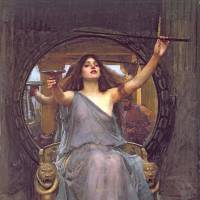Terror and tragedy are widely considered entirely disagreeable in principle. But audiences have for millennia taken pleasure in the pain of narrative spectacles in the arts. Fear is popular because it arouses curiosity in addition to revulsion. So, too, does the assemblage of Western works from the 16th to 20th centuries in "Fear in Painting."
"Kowai-e: Fear in Painting" was the first of five publications on the theme by a scholar of German literature, Kyoko Nakano. It and its successors enjoyed tremendous commercial success and ended up becoming an eight-part series produced by NHK Educational TV. The present exhibition is the 10-year anniversary of that first book, one that addressed revered art works like Diego Velazquez's "Las Meninas" (1656) and Matthias Grunewald's "Isenheim Altarpiece" (1512-16). Though much of what is exhibited in the present show is more minor by comparison because of travel restrictions and prohibitive expenses, even just exploring the architectural geometries of Giovanni Battista Piranesi's prints, or Francisco Goya's dark etchings, is time and money well spent.
Fear is covered in myriad forms in religion, death, vengeance and social ills like excessive gin consumption and poverty. A predominant concern is with romantic, theatrical bents portraying sensational beasts and beliefs, as with sirens who lure sailors to shipwreck or the Victorian-era fascination with fairies, partly inspired by Shakespeare's "A Midsummer Night's Dream." Much here requires supplementary narration to explain what is being seen.
Emotional surplus abounds. Ford Madox Brown's "Manfred on the Jungfrau" (1841-61) depicts the moment of apparent finale when the titular character of Lord Byron's supernatural poem, "Manfred," attempts to dash himself to death on alpine rocks far below. Wracked by a torturing though unspecified guilt, Manfred is, for the time being, saved from death by a hunter passing by.
Max Klinger's "A Glove" (1881) series represents an escalating flight from reality into increasingly horrifying fancy. A woman's glove found at a roller-skating rink substitutes for a man's original sexual desire. The glove subsequently becomes physically threatening in size and intention toward the male protagonist, before proliferating out of control.
Walter Sickert's "Jack the Ripper's Bedroom" (1906-07) is a shadowy and sketchy-looking painting. The artist held an abiding interest in the serial killer. A number of speculative books since the late 1970s attempted to cast Sickert as the real Ripper, marshaling his paintings in dubious support of the accusation. That Sickert also once lived in the supposed room of the Ripper he painted, however, seems to invest the painting with uncertain psychological significances.
The exhibition's signal work, "The Execution of Lady Jane Grey" (1833) by Paul Delaroche, is an extreme example of the fearsome fortunes of public popularity. With the subject of the blindfolded teenage queen groping her way toward the executioner's block, the painting was a cause celebre at the Paris Salon of 1834. Delaroche's academic style subsequently fell from fashion, and the painting disappeared into a private collection before entering what is now Britain's Tate Gallery in 1918. Declared missing after the 1928 Thames flooding of the gallery's basements, the work was thereafter proclaimed of negligible artistic importance anyway. Rediscovered by a curator in 1973, the intact and undamaged painting has since been on continual display for the past 35 years. A further fear for painting is in how its fortunes can change according to the whims and fancies of its audiences and their times.
"Fear in Painting" at the Hyogo Prefectural Museum of Art runs until Sept. 18; 10 a.m.- 6 p.m. (Fri., Sat. till 8 p.m.); ¥1,400; closed Mon. (except Sept. 18); www.artm.pref.hyogo.jp The exhibition moves to The Ueno Royal Museum; Oct. 7-Dec. 17; http://www.ueno-mori.org/ http://www.ueno-mori.org/

















With your current subscription plan you can comment on stories. However, before writing your first comment, please create a display name in the Profile section of your subscriber account page.